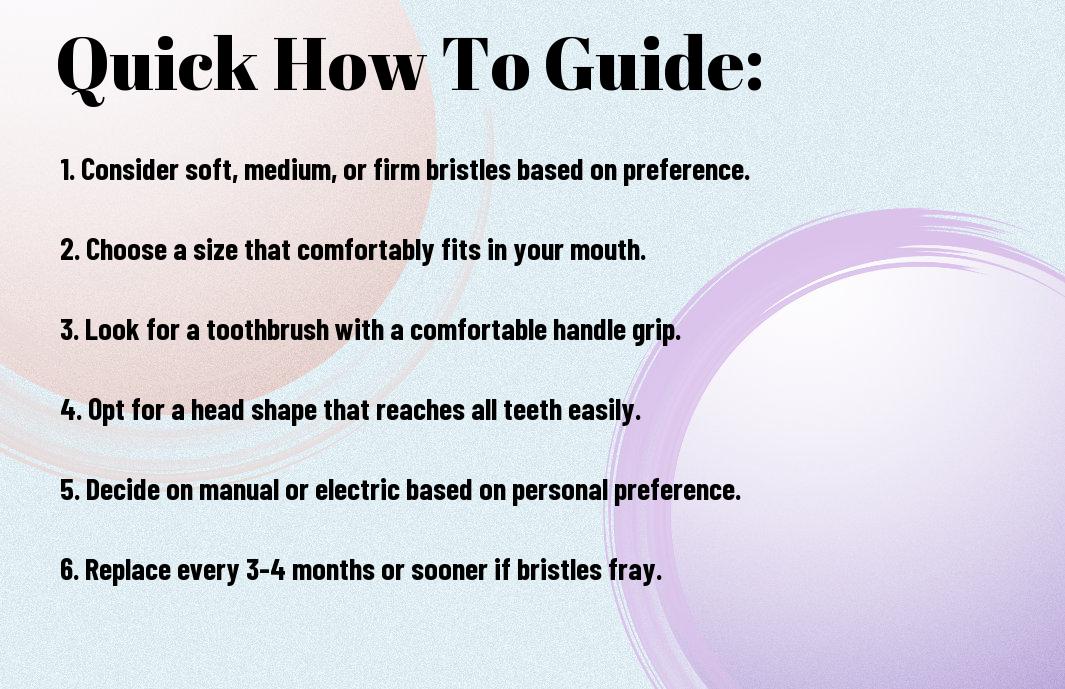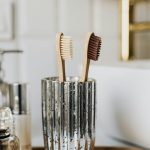How to Find the Right Toothbrush
There’s an overwhelming number of toothbrush options on the market, each claiming to be the best. However, selecting the right toothbrush is crucial for maintaining good oral health. From electric to manual, soft to firm bristles, there are many factors to consider. In this guide, we will help you navigate through the important features to look for in a toothbrush to ensure you find the perfect fit for your teeth and gums.
Contents
Understanding Your Oral Health Needs
Identifying Your Dental Concerns
An important step in choosing the right toothbrush is identifying your specific dental concerns. Whether you have sensitive teeth, gum disease, or stained teeth, understanding your unique needs will help you select a toothbrush that caters to those issues.
Considering Your Gum Health
Oral health goes beyond just your teeth – your gums play a crucial role as well. Healthy gums are necessary for overall oral health, as gum disease can lead to serious complications if left untreated.
It’s vital to choose a toothbrush that not only cleans your teeth effectively but also promotes good gum health. Look for a toothbrush with soft bristles to prevent any abrasion to your gums while still efficiently removing plaque and bacteria.

Factors to Consider When Choosing a Toothbrush
It’s important to consider several factors when choosing the right toothbrush for your oral health needs. Here are some key considerations to keep in mind:
- Bristle Type: Consider whether you prefer soft, medium, or hard bristles. Soft bristles are typically recommended by dentists as they are gentle on the gums and enamel.
- Electric or Manual: Clearly, you should decide between an electric or manual toothbrush based on your personal preference and needs. Some people find that electric toothbrushes provide a more thorough clean, while others prefer the simplicity of a manual option.
- Head Size: Which toothbrush head size is best for you? Compact heads may be easier to maneuver and reach difficult spots, while standard heads cover more surface area at once.
Bristle Type: Soft, Medium, or Hard?
Consider whether you prefer soft, medium, or hard bristles. Soft bristles are typically recommended by dentists as they are gentle on the gums and enamel.
Electric or Manual: Which is Best for You?
Clearly, you should decide between an electric or manual toothbrush based on your personal preference and needs. Some people find that electric toothbrushes provide a more thorough clean, while others prefer the simplicity of a manual option.
Which toothbrush head size is best for you? Compact heads may be easier to maneuver and reach difficult spots, while standard heads cover more surface area at once.
Tips for Selecting the Right Toothbrush Head
For optimal oral hygiene, it’s crucial to choose a toothbrush with the right head. Here are some tips to help you make the right decision:
- Size: Select a head size that comfortably fits in your mouth and can reach all areas.
- Bristles: Look for soft bristles to prevent damage to gums and enamel.
- Shape: Consider the shape of the head, whether round or oval, for better access to teeth.
Perceiving your individual needs and preferences will guide you towards the ideal toothbrush head for a healthy smile.
Angled Heads for Better Reach
Angled toothbrush heads are designed to reach difficult areas in the mouth with ease. The angled bristles can effectively clean along the gumline and between teeth, ensuring a thorough cleaning experience.
Ergonomic Handles for Comfort
With ergonomic handles, you can enjoy a comfortable grip that reduces hand and wrist strain during brushing. The specially designed handles are easy to hold and control, making your brushing routine more comfortable and efficient.
The ergonomic handles are crucial for individuals who suffer from arthritis or have dexterity issues, as they provide a secure grip and better control while brushing.
Interdental Brushes for Tight Spaces
Angled interdental brushes are perfect for cleaning tight spaces between teeth and along the gumline. These small brushes can reach where traditional toothbrushes can’t, removing plaque and food debris for improved oral health.
Ergonomic interdental brushes provide a comfortable grip for easy maneuvering, making them an excellent addition to your oral hygiene routine.
How to Choose the Right Toothbrush for Your Lifestyle
Travel-Friendly Options
Now, when choosing a toothbrush for your travels, consider opting for a compact and lightweight design that is easy to pack and carry. Look for toothbrushes with travel cases or covers to keep them clean and hygienic while on the go.
Battery Life and Charging Considerations
Now, if you prefer an electric toothbrush, pay attention to the battery life and charging options. Ensure that the toothbrush has a long battery life and convenient charging capabilities to suit your lifestyle. Some toothbrushes come with portable charging cases for added convenience.
Battery life and charging considerations are crucial when selecting an electric toothbrush. Look for models with long-lasting batteries and easy-to-use charging solutions to ensure your toothbrush is always ready for use. Portable charging cases can be a game-changer for frequent travelers or on-the-go individuals.
Environmental Impact: Eco-Friendly Toothbrushes
Life, when looking to reduce your environmental footprint, consider eco-friendly toothbrush options. Choose toothbrushes made from sustainable materials like bamboo or those that are biodegradable to minimize waste and promote eco-conscious dental care habits.
It is crucial to consider the environmental impact of your toothbrush choice. Opting for eco-friendly options made from sustainable materials can significantly reduce plastic waste and help protect the planet. Make a positive impact by choosing toothbrushes that prioritize environmental sustainability.
Specialized Toothbrushes for Specific Needs
Toothbrushes for Sensitive Teeth
Your sensitive teeth require a toothbrush with extra soft bristles to prevent irritation. Look for options with gentle bristles and flexible heads that can effectively clean without causing discomfort.
Toothbrushes for Braces and Orthodontic Work
While having braces or orthodontic work, a toothbrush with a small head and V-shaped bristles can help navigate around wires and brackets. Consider angled neck toothbrushes for better reach and effectiveness in cleaning hard-to-reach areas.
It’s necessary to use a toothbrush designed specifically for braces as it will be gentle on the metalwork while still being able to thoroughly clean the teeth and gums.
Toothbrushes for Children and Toddlers
Orthodontic toothbrushes for children and toddlers are designed with small heads and extra soft bristles to cater to their delicate mouths. Look for fun colors and characters to make brushing teeth an enjoyable experience for kids.
With easy-to-grip handles and non-toxic materials, these toothbrushes are safe and effective for maintaining your child’s oral hygiene.
Additional Features to Consider
Timers and Pressure Sensors
Keep an eye out for toothbrushes that come equipped with timers and pressure sensors. These features can help you ensure that you are brushing for the recommended two minutes and applying the right amount of pressure to avoid damaging your gums.
UV Sanitizers and Antibacterial Properties
Any toothbrush that offers UV sanitizing capabilities or antibacterial properties can be a great choice for maintaining oral hygiene. These features can help eliminate bacteria on your toothbrush, reducing the risk of reinfecting your mouth with harmful germs.
You may want to consider investing in a toothbrush with UV sanitizing capabilities or antibacterial properties to ensure that your toothbrush remains clean and free of harmful bacteria.
Customizable Brush Heads and Handles
It is important to select a toothbrush with customizable brush heads and handles to suit your specific needs. These features can help you achieve a more comfortable and effective brushing experience, catering to your unique oral care requirements.
For instance, if you have sensitive gums, you may benefit from using a toothbrush with soft bristles to prevent irritation. Customizable handles can also be beneficial for those who prefer a certain grip or size for better control during brushing.
To wrap up
Taking this into account, finding the right toothbrush is crucial for maintaining good oral health. Consider the size of the head, bristle strength, and handle grip to ensure maximum comfort and effectiveness. Remember to replace your toothbrush every 3-4 months or sooner if the bristles show signs of wear. Consulting with your dentist can also provide personalized recommendations based on your specific dental needs. By selecting the right toothbrush, you can improve your brushing technique and overall oral health.
FAQ
Q: Why is it important to find the right toothbrush?
A: Finding the right toothbrush is important because it contributes to maintaining good oral hygiene. A toothbrush that suits your individual needs can effectively remove plaque and prevent dental problems such as cavities and gum disease.
Q: What factors should I consider when choosing a toothbrush?
A: When choosing a toothbrush, consider the size of the brush head to ensure it can reach all areas of your mouth, the bristle type (soft, medium, or hard), the handle grip for comfort and control, and whether you prefer a manual or electric toothbrush.
Q: How often should I replace my toothbrush?
A: It is recommended to replace your toothbrush every 3 to 4 months, or sooner if the bristles become frayed. Using a worn-out toothbrush can be ineffective in cleaning your teeth and may harbor bacteria, leading to oral health issues.



